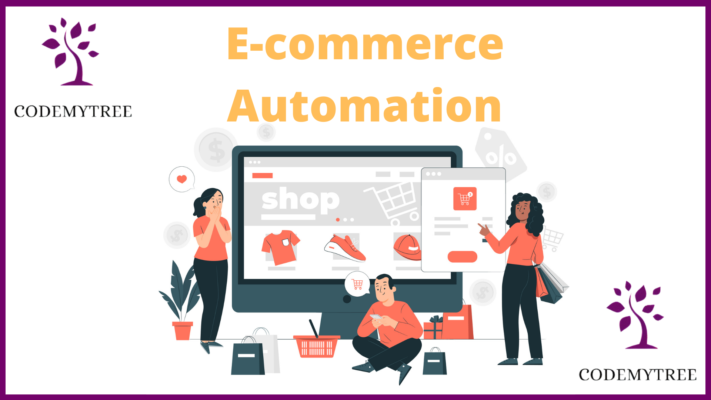
While running a business online, your major concern and lookout are attaining new customers and new orders. It would be a joyful movement for any online merchant to see their business grow. Growing business would also mean growing demand thereby resulting in increasing day-to-day tasks. Now, this might sound dreading as the tasks keep increasing and you slowly become inefficient because of the small repetitive tasks. Well, if you wish to bring in more customers and simultaneously handle every task efficiently, I think I got the perfect solution for that; E-commerce Automation.
What is E-commerce Automation?
Let’s derive a definition from the term itself.
- E-commerce refers to buying and selling of goods and services through the medium of the internet.
- Automation is the process of converting all the labor-required tasks into technical tasks which would require minimal human assistance.
So from these two definitions, we can derive that e-commerce automation refers to the process of using various software tools to automate your tasks which in turn reduces the burden of buying or selling your products and services to new as well as old customers.
Its main focus is repetitive, daily tasks. E-commerce automation helps you save time so that your team can focus on rather important tasks such as handling customer relations, thinking of innovative strategies, and focusing on the bigger picture.
What Are The Examples Of E-commerce Automation?
Some good examples of e-commerce automations are:
1. Welcome mail
When a new customer subscribes to your newsletter or purchases a new product, a mail is automatically send to them thanking them for choosing your service as well as welcoming them with a nice content text and offers.
This is also known as email automation.
2. Management of inventory
If a product is currently unavailable or out of stock, then the automation directly un-publishes it and re-publishes it when stock is available.
3. Suspicious orders
When an order has suspicious traits such as unmatched shipping and billing addresses is flagged as high-risk order which is triggered for manual check-in.
4. Customer segregation
Customers are divided based on purchasing patterns and are categorized based on how much business they bring. Campaigns and special offers are sent to them on that basis.
How Does It Work?
It works based on trigger actions. Sequences of actions are set on certain conditions which are triggered when activated. For instance, if you run a clothing business then the following actions could be taken:
- If a customer had made purchases above $7000, they can avail of up to 50% discount.
- If a customer has made purchases above $5000, they can avail of up to a 30% discount.
- Purchases made above $3000 can avail of a discount of up to 20%
Customers can be categorized on the basis of their purchases as well.
Trigger : When an order is placed.
- Condition 1: If in the entire buyer’s journey, the customer’s bill amounted to <$7000
- Action: Flag them as platinum user
- Condition 2: If in the entire buyer’s journey, the customer’s bill amounted to <$5000
- Action: Flag them as Silver user
- Condition 3: If in the entire buyer’s journey, the customer’s bill amounted to <$3000
- Action: Flag them as Gold users
Lastly, a common trigger is activated whenever a purchase is made: sending every customer a thank you mail upon placing an order.
Finally, You can bid goodbye to this manual work and focus on the others.

Importance Of E-commerce Automation
By automating eCommerce, businesses can enhance their customer experience (by segmenting and offering personalized options) while simultaneously prioritizing and delegating tasks that require strategizing and social skills. You can benefit from eCommerce automation in the following ways:
1. Time efficient
“Remember that time is money.”
Benjamin Franklin
For a business person, money is their greatest asset. E-commerce automation saves time as it automates various repetitive workflows through a set of conditions.
2. Upward business trend.
Streamlining processes, categorizing store data, and reorganizing tasks can help you manage all of these functions effectively.
According to recent statistics, ecommerce automated tools could save merchants up to 30% on financial and human resources while still meeting growth targets.
Moreover, less time spent on daily repetitive tasks means more time for innovative, strategic and decision-making tasks – the keys to growth.
3. Consistency and accuracy
It is easy to automate tasks because you only need to set the workflow up the way you want them performed, and the software will take care of everything else.
Manual work, on the other hand, requires you to always keep track of which procedures to follow and when, always with the possibility of human error.
Automate Your Workflow today!
We believe every ecommerce brand and retailer, large and small, should be applying automation as much as possible, for one very simple yet important reason: The more you automate, the more your business can thrive.
Automation allows you to save a lot of time and resources. It makes your business processes much faster and more efficient. It helps increase the effectiveness of marketing and sales activities. And most importantly, automation brings you the freedom to focus on the things that matter most to your business.